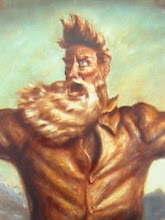One favorite tactic was for us squaddies to fill up a five gallon bucket with water, climb to the roof of the station, lie in wait for the engine to return, then bombard the firefighters as the engine entered the building. As E208 was a two person cab, the two firefighters rode on the tailboard, exposed to the elements. Helmets were usually removed as the engine pulled into the alley, leaving the targets even more exposed.
The trick was to aim slightly ahead of the firefighters, so that the distance the engine would travel during the flight of the water would bring the target to the water at the precisely the right time. Although it took practice, the results were spectacular and produced a thorough soaking.
An effective tactic, though if not part of a strategic plan, only a fleeting success.
You see, though soaked, the victims were in no way incapacitated. The attackers were vulnerable, isolated on the roof with only one way down. Retribution could be quick and equally effective.
He who controls the ladder, wins the war!
Two hose bibs were located close enough to the roof access, so that the egress could not be accomplished without receiving a vicious counter attack. One of the bibs was actually fitted with a one inch connection and a two inch supply pipe. The attached one inch hose line made for a fearsome attack line which could be extended for several hundred feet if necessary. Also, as station #208 had old school tile flooring, the place was lousy with buckets.
The strategic plan called for a preemptive sweep of the area, disconnecting the hoses from the bibs and removing them from the area. Attention was paid to buckets, ice chests and any other container which could hold water - they were removed as well. Additional buckets were filled and placed at the top of the ladder so that the could be used to douse someone attempting to climb the stairs. On rare occasions, a 35' foot ladder was available to spot on the west side of the building for use as a secondary escape route.
Allies were an added bonus, though the truckies tended to be advanced in years and often acted far more mature than us juveniles.
No one ever got hurt on our shift, no doubt due to divine intervention. With all of the water flying onto the access ladder, it is a miracle no one fell off. I don't remember the captains getting after us on this issue, unless it was late at night and they wanted to sleep. We all slept in the same large dorm room back then. Battles tended to shift throughout the station and they were never silent.
There are big changes in store for station 208, a major renovation will remove existing the roof access and will replace it with an enclosed common stairwell. That really doesn't matter much any more, we are forbidden by policy to ride tailboard and fully enclosed cabs pretty much take all of the fun out of throwing water on the engine anyways.
I occasionally have to still climb that access ladder, I am working on a project that requires it. Each time I climb I can't help but think to myself, "he who controls the ladder, wins the war".
I likely will never forget that strategy.
Thanks for reading,
Schmoe



We have similar games but with the complaints from fellow officers up, its not worth it.
ReplyDeleteI remember the days when a bottle of water would get dumped in your drivers seat while you were at a call and it wasn't until you were driving that you realized your butt was all wet. Or the baby powder or worse pepper spray in the vents.
Mr. Police Man - Way way back in the day, our District Commanders drove police interceptors that were painted red and white. They had vinyl bench seats that ran across the front.
ReplyDeleteThe firefighters used to like to "detail" the cars by applying armor all on the front seats. Apparently, the D.C.s grew weary of sliding around while driving, as they put a stop to the practice.
Of course I am sure there was a little "midnight detailing" that went on.
Good times.
Thanks for the comment.